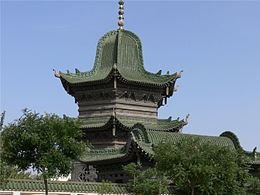Ma Hualong
| Part of a series on Islam in China |
|---|
 |
|
|
Ma Hualong (
From the beginning of the anti-Biography
Ma Hualong became the leader of the Jahriyya ca. 1849,[1] succeeding the menhuan's fourth shaykh, Ma Yide (late 1770s – 1849[3]). Although the Jahriyya had been originally created by Ma Mingxin in the central Gansu, by the time of Ma Hualong's succession to the leadership position the order was centered in the northern Ningxia (which in the 19th century was also part of Gansu Province), its headquarters being located in
Since the beginning of the Muslim Rebellion in 1862, Ma Hualong was based at the Jahriyya headquarters in
At some points during the rebellion Ma Hualong negotiated with the authorities, and at least once he even surrendered, taking a new name, "Ma Chaoqing" ("one who attends on the
Ma was besieged in Jinjipu in July 1869 by the
Existing accounts on Ma Hualong's death differ. It is likely that he was executed on Zuo's orders on March 2, 1871, along with his son Ma Yaobang and over eighty rebel officials
Family and succession
Few of Ma Hualong's family survived the massacre at Jinjipu. Two his grandsons, Ma Jincheng and Ma Jinxi, were sentenced to castration upon reaching the age of 12. Ma Jincheng ended his days as a eunuch slave in Kaifeng in 1890, although the new Jahriyya leader, Ma Yuanzhang (the 1850s–1920), managed to secretly provide him with some support until his death. The younger grandson, Ma Jinxi, was spirited away, intact, from his Xi'an confinement by Ma Yuanzhang, and was hidden at a Hui household in Hangzhou.[10]
Zuo executed a lot of Ma's relatives, except his daughter and grandson, who was sent to Yunnan. The grandson's name was Ma Tsen-wu.[11]
Many years later, Ma Yuanzhang managed to obtain a pardon for Ma Jinxi, and Ma Hualong's grandson returned to Ningxia. A split within the Jahriyya followed, with some members becoming followers of Ma Jinxi, and others holding for Ma Yuanzhang (who claimed descent from the order's founder Ma Mingxin, and was also related to Ma Hualong's family through his marriage).[10]
Legacy

According to Jahriyya adherents in Ningxia, Ma Hualong's grave is in Dongta Town, which now is a suburb of
Adherents of a rival tradition within Jahriyya, however, believe that Ma Hualong's true tomb is in Xuanhuagang, in Gansu's Zhangjiachuan County,[13] which, coincidentally, was the base of Ma Hualong's successor, Ma Yuanzhang.
Some authors try to reconcile the two traditions, by saying that Ma Hualong's body is in Dongta, and the head is in Zhangjiachuan.[14]
References
- Michael Dillon (1999), China's Muslim Hui community: migration, settlement and sects, Routledge, ISBN 978-0-7007-1026-3
- ISBN 978-0-674-59497-5
- Jonathan N. Lipman, "Ethnicity and Politics in Republican China: The Ma Family Warlords of Gansu" Modern China, Vol. 10, No. 3 (Jul., 1984), pp. 285–316. (JSTOR)
- Jonathan N. Lipman, "Familiar Strangers: A History of Muslims in Northwest China (Studies on Ethnic Groups in China)", University of Washington Press (February 1998), ISBN 0-295-97644-6.
- The mausoleum of Ma Hualong Photo made c. 1936 by Claude C. Pickens. This photo, and many related photos, in the proper context, can be found by going to the Harvard University Library Visual Information Access site, and entering "Pickens" and "Ma Hualong" in the first two of the search boxes.
Notes
- ^ a b c d e f Dillon (1999), pp. 124–126
- ^ a b c Dillon (1999), pp. 66–68
- ^ Lipman (1998), p. 179
- , when used as a suffix in place names, is pronounced pu.
- ^ a b c Lipman (1998), p. 125
- ^ Until the early 20th century, Gansu Province also included today's Ningxia and Qinghai
- ^ Lipman (1998), p. 121
- ^ Garnaut, Anthony (2008). "From Yunnan to Xinjiang: Governor Yang Zengxin and his Dungan Generals" (PDF). Études Orientales (25): 98. Archived from the original (PDF) on 2012-03-09.
- ^ Dillon, p. 66. The book does not actually state the year, but it appears to be 1869 from the context.
- ^ a b Lipman (1998), pp. 179–181).
- ISBN 978-0-919642-85-0. Retrieved 2010-06-28.
- Journal of Asian Studies, August 1987, Vol. 46 (3): 495–532.
- ^ Dillon (1989), p. 126; Gladney (1996), p. 50; the place is called "Zhanquanchuan" in Dillon, however
- ^ Gladney (1996), p. 50
